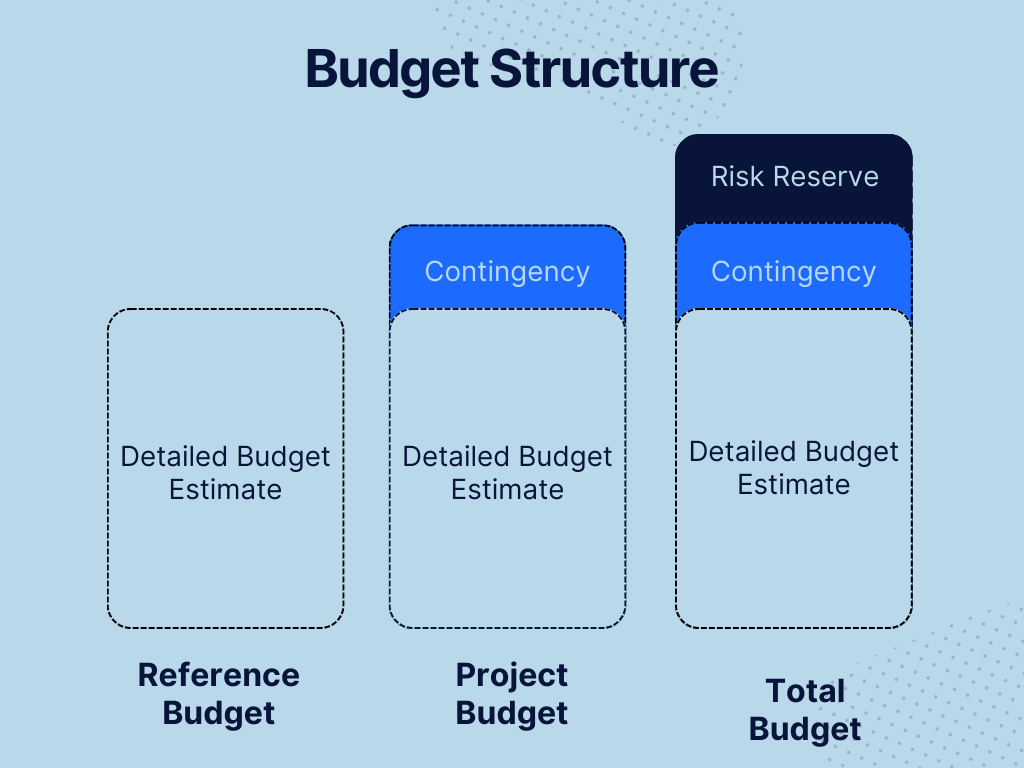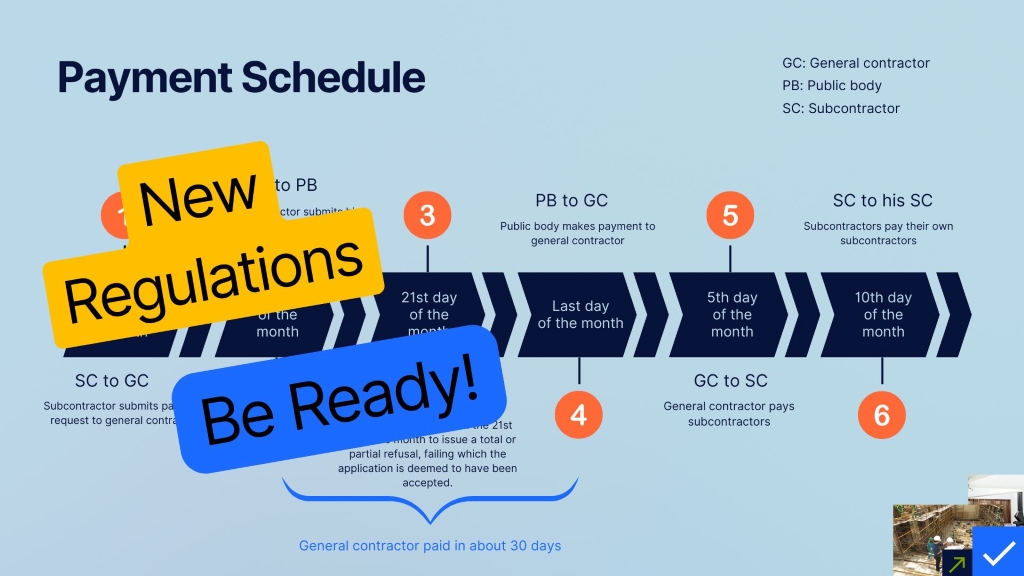In the world of construction projects, even the most meticulous planning cannot eliminate all uncertainties. From unexpected site discoveries to fluctuations in material prices, unforeseen events are commonplace. To compensate for these uncertainties, a common practice is to establish a contingency allowance—a financial reserve intended to cover these unexpected costs. To this end, the PMI in its 7th edition of the PMBOK Guide recommends that:
"The project budget should include a contingency allowance to account for uncertainty. Contingency reserves are set aside to implement a risk response or to address risk events if they occur."
Generally, this allowance ranges from 10% to 20% of the total project budget, depending on the complexity, delivery method, and the initial level of risk or uncertainty. When developing the budget, it is also possible to provide for several contingency allowances to facilitate their use and tracking during the project, such as a design contingency and a construction contingency.
However, the mere existence of a contingency raises many practical questions: How should it be funded and used? Should it be included directly in the initial contract? Is it acceptable to use it for additions to the project if it is not fully spent? Let's explore together the best practices for effectively managing these allowances together.
Financing the Contingency
In one of our previous articles, we detailed the fundamental difference between project financing and the project budget. On this topic, before starting the project, it is recommended that contingency financing be included in the project's funding, and not just appear as a budget line item.
A contingency without allocated funds is merely an illusion of security. For it to act as a true safety net, it must be tangible. In practice, this means that contingency funds must be reserved and set aside from the project's initiation phase, thus ensuring their immediate availability when needed. This prevents delays related to funding revision requests, better represents the true cost to anticipate for the project, and avoids a lack of funds in case of unforeseen events.
When and How Can I Use the Contingency Allowance?
Once funded, the contingency allowance is generally not at the project manager's free disposal. These funds are usually assigned to unforeseen situations to achieve the originally planned scope of the project (or the contract in question). To use the allowance, a clear process for contingency use is essential. This typically involves:
- A formal Change Request (CR): The project manager must justify the need to use the funds by describing the nature of the unforeseen event, its financial impact, and the proposed solution.
- Approval from a competent authority: Once documented, the CR is submitted to an approval workflow to validate the use of funds, ensuring rigorous supervision and traceability.
This approach ensures that the funds are used only for legitimate unforeseen events and not for unplanned additions to the project scope, which should be subject to a separate project change request process.
This method ensures transparency, optimal management of the allowance, and all the necessary documentation in case of an audit. Ultimately, this framework provides a better understanding of the nature of unforeseen events to refine contingency estimates for future projects.
Generally, each organization defines its own rules and best practices for using the contingency allowance. Refer to your organization's documentation, keeping in mind the concepts detailed here.
Including Contingency in the Contract: A Good Idea?
Although the contingency allowance can be divided (or allocated) to each contract, you have the choice of whether or not to include it in the initial contract awarded to the supplier.
If it is not included initially, it will reinforce the need to properly document change requests to increase the contract value when necessary. If it is already included and awarded directly to the supplier to limit administrative processes, be vigilant! Make sure the supplier clearly understands that a contingency is already included and that it cannot be used without your prior approval.
In all cases, during the contract's execution, pay close attention to the various payment requests so that the invoiced items are correctly separated between the elements planned in the initial scope of the contract and the unforeseen expenses paid from the contingency.
Re-evaluating Contingency Throughout the Project
The contingency allowance is not static. As the project progresses and uncertainties are resolved, it is wise to regularly re-evaluate the amount of the remaining contingency. At the end of the project, a portion of the unused contingency may be released or reallocated, depending on your organization's policy.
Important! Unused contingency cannot be used as an opportunity to add items to the project that were not originally planned. Scope additions must be managed through a separate change process, the project modification, with its own analysis and approval process.
Project Contingency vs. Management Reserve
In addition to contingencies, some organizations will also provide a reserve for risks. Although there are similarities with project contingencies, it is important to distinguish the contingency allowance from the management reserve. The PMI differentiates the two allowances as follows (Section 2.8.5.3 of the PMBOK® Guide – 7th Edition):
"The [management] reserve is an amount of time or budget set aside for managing risks. The contingency reserve is used to manage identified risks, should they occur. The management reserve is a budget category used for unknown events, such as work that is within the scope, but unplanned."
In practice, each organization often has a more specific policy governing in which situations one or the other of the allowances can be used. In general:
- Contingency is intended for identified risks and known uncertainties
(known-unknowns). It is generally under the control of the project manager, with a well-defined operational process for using the funds (see above). Examples include errors or omissions during design, an adjustment of required quantities, unfavorable weather, or delays due to poor team coordination. - Management reserve (or risk reserve), on the other hand, is allocated for unforeseen risks (unknown-unknowns) and is generally managed at the management or program level. It is used for more macro-level events that could not have been identified during initial planning. The sudden imposition of tariffs, natural disasters, supply chain disruptions, and strikes are examples of events that are difficult to predict, but whose additional costs could be drawn from the management reserve.
Regardless of the rules governing the use of these two allowances, the project manager must be able to document and get approval for the withdrawal of each amount and then track the amounts drawn from each allowance. In short, the following figure illustrates the three different parts that can structure the budget component of a project.

Aidi: A Solution to Support the Project Manager in Contingency Management
Proactive and disciplined management of contingency allowances is a cornerstone of success in construction projects. By ensuring its funding, a clear process, and rigorous traceability, organizations can turn the unforeseen into an opportunity to strengthen their projects.
To help the project manager apply these best practices, the organization can equip itself with project management software. In this regard, a construction project management solution for project owners like Aidi can allow them to:
- Forecast and request the necessary funding for contingency directly from annual funding envelopes.
- Clearly document the budget items assigned to the project contingency or the contingency allocated to each contract.
- Justify and get approval for all change requests charged to the contingency allowance following your internal processes.
- Separate, in the progress payments, the progress of the initial contract from the contingency items, thus ensuring rigorous contract management.
- Distinguish, where applicable, the expenses taken from the management reserve versus expenses taken from the the contingency allowance.
- Continuously track and re-evaluate the contingency allowance by calculating the percentage consumed in real time.
Curious to learn more about how Aidi can help you better manage your project contingencies? Contact us for a product demonstration!






